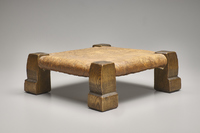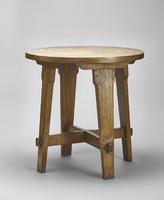Introduction
This exhibition centers around a remarkable group of furniture about which only the barest details are known. With the exception of the sideboard, all of this furniture belongs to a larger order, originally purchased by a single buyer in the Finger Lakes region of New York State in the early years of the twentieth century that, remarkably, remained together until 2001 when they first appeared on the market. Despite the broad distribution and national reputation that Stickley enjoyed in this period, very few complete orders of this early furniture have survived intact; this is one of a small handful that have come to market in the last five decades. Adding to this group’s historical significance is the rarity of forms, for not only do these objects represent some of the firm’s most successful designs as Stickley began to embrace the Arts and Crafts movement and develop his own aesthetic sense, but the extensive use of ash and green finish on these pieces places them amongst the most important of Stickley’s productions. Lastly, this furniture survives in a remarkable state of preservation, for although the bright green of the finish has lessened over time with exposure to light, traces of these fugitive pigments still remain on the exterior, probably due to the fact that this lake home was closed up and the furniture protected at the end of each season.
In the course of researching this furniture and preparing the exhibition, new light has been shed on Stickley’s manufacturing process, his marketing efforts, and provided unexpected insight into the factory workers who–because the payroll records from this period have not survived–have been largely anonymous in the previous scholarship on Stickley. It has also meant that, perhaps for the first time, the full and disparate range of production dates for these pieces could be narrowed by documenting and considering their places within the broader context of the total order. The goal of the exhibition is thus twofold: first, we wanted to share this incredible group of furniture with our audiences. Second, we wanted to explore new ways to think about Stickley’s life and work as part of the Museum’s broader mission to bring his message to new and diverse audiences.
If good fortune somehow conspired to present this furniture, more than 100 years later, in a near-pristine state, we also need to acknowledge the original owner and his descendants who closed the home each year, who put slip-covers over the original leather rather than replacing it, and who recognized the importance of this furniture and called in an expert to help them when the time was right. Most importantly, the Stickley Museum at Craftsman Farms and viewers enjoying these exquisite objects owe a profound debt of gratitude to Gregg and Monique Seibert whose generous gift of this furniture in 2018 has made this exhibition possible.
Jonathan Clancy, Director of Collections and Preservation
May 2020


